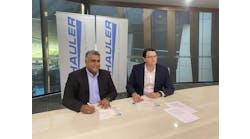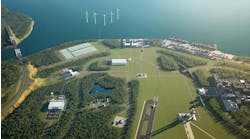Harry Hauptmeijer, president of Yokogawa Europe, gave the update and review of the current Yokogawa Group business position at last month’s user group meeting in Holland, mentioning specifically that Tom Lee, who is MD of Yokogawa Electric International in Singapore, is the first non-Japanese national to be appointed to the Yokogawa board, perhaps reflecting that 60% of sales in 2009/10 had been overseas. In Europe the sales turnover was Euro 325million, of which 80% is now from industrial automation, with 1425 employees: the European operation had received significant recent investment into building the Amersfoort HQ, which also is the production centre for pH and conductivity sensors, and other analytical equipment: plus a new production hall for Coriolis and other flowmeters at the Rota factory in Germany – a business that is now 100 years old.
For Yokogawa, the 2009 results are for the 12 months ended 31st March 2010, and the overall financial figures for the group, from the website show this as "the second year of consolidation and structural reform", marking a two year time-out from their master plan to be the #1 world industrial automation supplier in 10 years from 2000: sales dropped 15.9% to 316 billion Yen, and resulted in a net loss of nearly 15 billion Yen - a better result than 2008, when the loss was 38 billion. The restructuring has led to the separation of Test and Measurement Equipment from Industrial Automation and Control: this identified that IAC operating income was 20 billion Yen, on 257 billion sales, with income dragged down in group terms by the operating loss of 19 billion Yen on the 31 billion of sales at T+M. So the policy now in operation is to focus resources onto the IAC business, and the first visible result was the transfer of 200 staff - mainly development engineers - from T+M to IAC early in 2009.
The R+D spend trend reflects this change of emphasis: for 2009 T+M slashed their budget by half or 10 billion Yen, but the trend in IAC is distinctly up, at 16.8 billion Yen in 2009, and budgeted for 19.5 billion in 2010. In response to the containment of the losses in 2008, CAPEX in 2009 was also slashed to 33% of the previous year, but is now budgeted to recover, up 50% for next year.
R+D spend
The current R+D spend in IAC can be compared to other players in the industry: Hauptmeijer pointed out that, at 7.3% of sales, this investment was higher than any of their competitors, by an average factor of about 2x, over the last three years, and this was not just a factor resulting from the Japanese Yen being relatively high. Relative figures were Emerson at 1.8%, ABB 3%, Invensys 3.5%, Honeywell 4.2%, and Siemens 5.5%.
Other user conference topics will be covered in separate reports on the INSIDER blog at www.iainsider.com.



